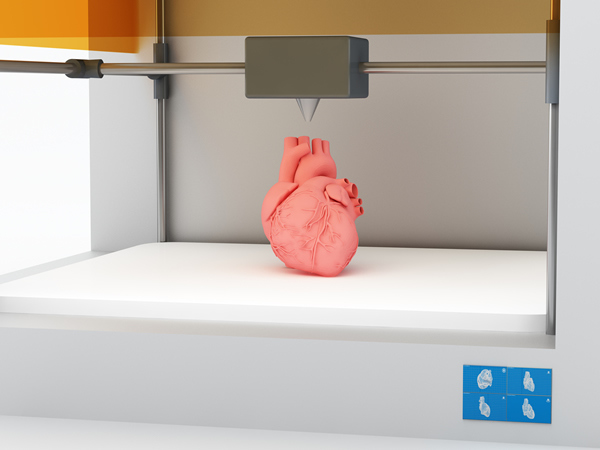ATD Blog
3-D Printing Moves Healthcare to a New Era
Mon Jul 11 2016

To radically decrease risks for patients during medical procedures, healthcare pioneers and innovators are developing accurate 3-D printing technology. Synonymous with “additive manufacturing,” which refers to creating a three-dimensional object by adding successive layers of material as guided by a computer, many industry experts are calling this the “third industrial revolution.“
Essentially, this development means that 3-D printers are akin to industrial robots. And the FDA is stepping up to the plate. Currently, the federal agency is welcoming and encouraging comments on this evolving tech. The FDA also has issued guidance on social media about 3-D medical devices, designed with patients in mind.
Clearly, the healthcare community sees the potential of 3-D printing to successfully improve the patient experience—while also innovating and transforming training, learning, and workforce development. For instance, 3-D printing advocates have created and tested a high-quality and realistic simulations of the human body.
The Healthcare Global Community Perspective
No doubt, technology has been evolving over the past two decades in the healthcare community. As costs become lower and product refinement improves, this technology will play an increasing role in how to treat, manage, and prevent disease—ultimately transforming all of medicine, including how healthcare institutions learn, mentor, and coach in the field.
At the forefront of patient-centered care and the digital health revolution is additive manufacturing (also called 3-D bioprinting), which crosses the line between data and clinical practice—bringing out the best by combining the two. Some surprising developments globally have come in the form of 3-D–printed organs to blood vessels to prosthetics to pills.
Case in point: Wake Forest School of Regenerative Medicine has been printing organs and tissue. New initiatives also include a gel that hardens from a liquid to a living tissue, vascularization of new organs, organ scaffolding, and cells layered to grow naturally. The goal is to create custom-printed transplants made from a patient’s own or closely matched cells, precluding rejection and ensuring long-term success.
Meanwhile, in the area of artificial limbs, Scott Summit at Bespoke Innovations brought a designer’s eye and 3-D printing technical expertise to personalized prosthetics. The innovation continues offering a first-of-its-kind mobile app that streamlines the process of fitting patients for a customized 3-D–printed prosthetic cover. The app guides users through each step of measuring the patient, including help taking the relevant photos to create a model for optimal fitting. (Check out his TED Talk to learn more.)
Ever since printing the first blood vessel in 2009, Organovo designs with the goal of creating functional, three-dimensional tissues to repair or replace damaged or diseased tissues; these teams partner with biopharmaceutical companies. In addition, an academy to revolutionize pre-clinical testing has created in vitro tissues to test drugs before administering them to a living person, which is a definite contribution to the patient safety.
Finally, consider the example of how Mayo Clinic has helped 11-year-old with Blount’s disease. Indeed, the growing incidences of 3-D innovation are staggering, including bone cancer implants, skin, sensors, medical equipment. This innovation is not without caution, though.
Even though 3-D printing has the potential to disrupt healthcare in a positive ways, regulation is a concern. Consequently, the FDA is moving to regulate additive manufacturing—vital to ensure patient safety. Hopefully, such regulation doesn’t also curtail innovation.
The Goal and Ambition
As the healthcare impact of 3-D printing expands from the dentist office to surgical theater, the magnitude of emerging technology for healthcare stakeholders exponentially increases. In fact, the global healthcare community has been involved in efforts to support this innovative technology.
For example, during a recent trade mission visit to India, Dr. Peter Verschueren spoke about innovation in Flanders, and how the internal structures of Materialise are supporting innovation in medical 3-D printing around the world. During another session, a representative of the Indian Institute of Science, Bangalore talked about their research at a high international level. Moreover, Dr. Kappanayil Mahesh from the Amrita Institute of Medical Sciences and Research Centre Kochi shared two clinical cases and successful experiences with the use of 3-D–printed cardiovascular models for their complex case planning.
Bottom line: The science and technology behind 3-D bioprinting is advancing. Learners and trainers are ready to support and apply these medical and patient care advantages—providing safe and efficient communication and education.
Add Your Voice
Is your organization aware of these rapid and highly innovative advances? Does it understand the immediate impact on your patients and the talent development needs of your health, executives, administrators, instructional designers, and CLOS professionals? Let’s go above and beyond. We embrace the spirit of continuous innovation and change that fuels 3-D printing learning and talent development. What’s more, we are ready to apply the latest insights to inoculate our members and followers against the status quo.
The ATD Healthcare Community of Practice is looking forward to a blog full of sharing and learning experiences. Please add your thoughts, suggestions, and questions in the Comments section below.
